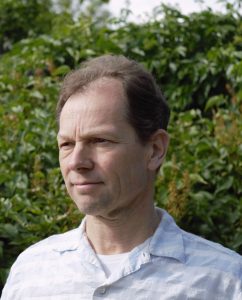
Jan-Willem Jansens has been restoring landscapes in New Mexico for three decades. Owner of Ecotone Landscape Planning, he is part of a network that works to restore land that has been damaged by generations of mismanagement. Using low-tech methods, they restore soil, ground and surface water, trees, and habitat––for the benefit of large-scale landscapes, including forests and watersheds, wetlands and streams, farm and ranch lands, and human communities. As he describes in the podcast, this is the work of decades, and involves not only executing the projects themselves, but also navigating bureaucracies, organizations, landowners, culture, and history.
2’59 what is “landscape” in terms of landscape scale planning
4’30 how landscapes have degraded in New Mexico
6’22 the loss of the soil “sponge”
7’44 all landscape-scale work is done in large networks of people doing soil, water, forest, wildlife people working together
8’53 studying landscapes since childhood via parents
9’57 restoring function to landscape, not restoring to a particular historical set of conditions
10’31 what rewetting the land loos like using simple structures
11’17 learning from native people and Bill Zeedyk
12’54 how do you actually build soil
14’47 how long it takes soil to build–years to decades, not hundreds or thousands of years
16’05 watching regeneration over years
17’04 putting thinned wood on the forest floor creates water retention. It can also help with low-intensity burns
18’13 fire ecology, the necessity of fire in forests to rejuvenate
19’47 what makes a high-intensity crown fire
22’30 water is not a fixed quantity
23’25 applying back yard garden principles across large landscapes
23’54 watershed planning is a relatively recent thing–only since the 1990s
24’33 forest planning has been going on since the 1980s
25’40 harvesting and slowing water in the landscape
25’59 we need to preserve snow
26’27 the difference between rain and snow
28’53 how to keep snow on the ground–using shade and low winter sun and windbreaks
31’10 what snow retention processes look like
32’43 can for-profit forestry be part of conservation
34’31 how you keep industry in check
34’57 important to engage communities and counties in planning for a balanced approach to industry
36’00 success stories
36’28 reintroduction of beavers
38’08 raising up the level of the river
40’07 the whole area has become wetland meadow
40’48 the beaver dams led to a permanent flow of water in the river and the acequias
42’03 cottonwoods and willows coming back
43’07 the challenges of working with governments, funding sources, communities, etc
44’19 cultivating stewardship awareness among landowners so they learn to see themselves as part of an interconnected watershed
45’08 fostering connectivity and wildlife corridors
46’28 getting funding cycles to work at nature’s pace rather than that of electoral cycles
47’32 groups of local, community, and landowner groups on the ground is essential for success–it’s all about collaboration and cross-pollination
49’18 is federal money going to the uses it was intended for?
51’02 local leadership needs to be built up
51’56 the importance of listening across cultures
53’29 the importance of working with community people
55’04 saving money through better stewardship
56’59 getting dialogues going so that people can see the effects of land use
58’49 beneficial grazing methods can stimulate healthy growth of the grass and soil development
59’58 people, planet, profit, and a new piece: Inspiration
1:02’08 inspiration is an important part of all decision making
1:02’58 using a social approach that mimics how nature works, everyone does their part
1:05’00 where his sense of hope comes from
1:05’29 too much media in our lives can be overwhelming because they make money through bad news. Best to look at what you and your networks can do…you can make a difference
